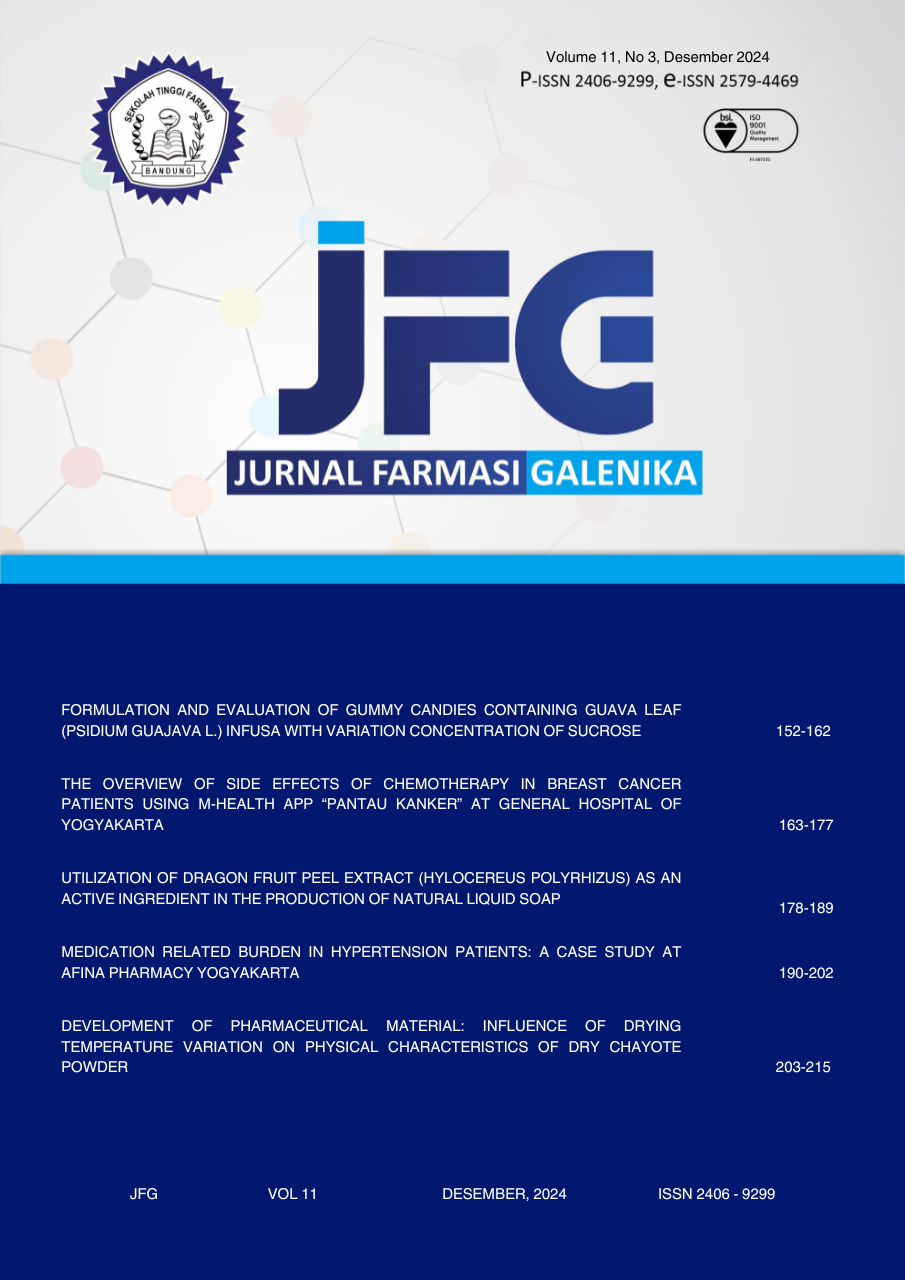The Overview Of Side Effects Of Chemotherapy In Breast Cancer Patients Using M-Health App “Pantau Kanker” At General Hospital Of Yogyakarta
DOI:
https://doi.org/10.70410/jfg.v11i3.345Keywords:
breast cancer, Monitoring side effect, M-Health appAbstract
Breast cancer is a type of cancer with a fairly high death rate. DIY Province has the highest prevalence of breast cancer in Indonesia. One of the medical ways to treat cancer is chemotherapy which uses cytostatic drugs, aimed at killing or slowing the growth of cancer cells. However, these drugs cause side effects in patients. Education is needed in dealing with side effects in order to monitor the patient's condition. Therefore, this research was conducted to determine the incidence of side effects of chemotherapy in breast cancer patients who use the M-Health app "Pantau Kanker" at Yogyakarta General Hospital. The research method used descriptive observational, with 41 patients as respondents. Recruitment was carried out using informed consent based on inclusion and exclusion criteria. Data collection was carried out using CRF (case report form) monitoring drug side effects. Data collection was carried out on the first, third and fifth days after chemotherapy. Monitoring is carried out through direct interviews with patients and through searching medical record data. Monitoring for nausea, vomiting and pain is carried out using the "Pantau Kanker" application based on the M-Health app with the VAS (visual analogue scale). The results of this study showed that nausea often occurs on the first day, due to immediate side effects (24 hour duration). Then, those including delayed ADRs such as anorexia, insomnia are often found on the third day, while on the fifth day the majority occur alopecia and tingling pain. Some side effects, such as diarrhea, constipation, stomatitis (mouth ulcers), and fever, are not experienced by many patients. Some side effects, such as diarrhea, constipation, stomatitis (mouth ulcers), and fever are not experienced by many patients. The therapy regimen used is dominated by low emetogenic, so that the majority of side effects that appear are in the mild category and do not interfere with the patient's activities. The conclusion of the study shows that monitoring of side effects when using cytostatic drugs occurs between days 1 to 5, the majority are in the mild category so that the patient's daily activities can still run well.
Downloads
References
Breen, S., Kofoed, S., Ritchie, D., Dryden, T., Maguire, R., Kearney, N., & Aranda, S. (2017). Remote real-time monitoring for chemotherapy side-effects in patients with blood cancers. Collegian, 24(6), 541–549. https://doi.org/10.1016/j.colegn.2016.10.009
Dwi Novrianda, Elisabeth Siti, Fitri Haryanti, Edy Supriyadi. Pengaruh Manajemen Gejala Akibat Kemoterapi dengan Mobile Health terhadap Kualitas Hidup pada Anak Leukemia Limfomablastik Akut. Desertasi. UGM 2022
Hutagaol, R., Sari, K. M., & Fratama, F. F. (2023). Manfaat Penggunaan Mobile Health sebagai Strategi Intervensi Mengurangi Efek Samping Kemoterapi pada Pasien Kanker. Journal of Telenursing (JOTING), 5(2), 3111–3119. https://doi.org/10.31539/joting.v5i2.6643
Kemenkes R.I. (2015). Permenkes No. 67 Tahun 2015 Tentang Penyelenggaraan Pelayanan Kesehatan Lanjut Usia Di Pusat Kesehatan Masyarakat. Kementerian Kesehatan Indonesia, 16, 89.
McQuade, R. M., Stojanovska, V., Abalo, R., Bornstein, J. C., & Nurgali, K. (2016). Chemotherapy-induced constipation and diarrhea: Pathophysiology, current and emerging treatments. Frontiers in Pharmacology, 7(NOV), 1–14. https://doi.org/10.3389/fphar.2016.00414
Ozusaglam, E., & Can, G. (2021). The Impact of the Perception of Chemotherapy-Induced Alopecia on Psychosocial Life. Florence Nightingale Journal of Nursing, 29(3), 361–370. https://doi.org/10.5152/fnjn.2021.19098
Pratiwi, U., & Dewi, T. S. (2017). Penatalaksanaan noma pada pasien limfoma non hodgkin Departemen Ilmu Penyakit Dalam dengan diagnosis Departemen Ilmu Penyakit Mulut meliputi steroid topikal , vitamin B 12 , asam folat , serta kompres. 3(3), 77–84.
Rochmad Basuki, A., Perwitasari, D. A., & Hardiyanto, H. (2020). Adverse Drug Reactions (ADRS) Antikanker pada Pasien Ca Mammae yang Menjalani Kemoterapi di RSUD Kota Yogyakarta. Jurnal Health Sains, 1(6), 349–359. https://doi.org/10.46799/jhs.v1i6.63
Shinta, N., & Surarso, B. (2016). Terapi Mual dan Muntah Pasca Kemoterapi. Jurnal THT-KL, 9(2), 74–82. httphttps://journal.unair.ac.id/download-fullpapers-thtklac6b53d6eefull.pdf
Sin, C., Kim, H., Im, H. S., Ock, M., & Koh, S. J. (2023). Development and pilot study of “Smart Cancer Care”: a platform for managing side effects of chemotherapy. BMC Health Services Research, 23(1), 1–10. https://doi.org/10.1186/s12913-023-09871-0
Downloads
Published
How to Cite
Issue
Section
Citation Check
License
Copyright (c) 2024 Ginanjar Zukhruf Saputri, Kanindya Nur P, Woro Supadmi, Akrom Akrom, Muh Muhlis

This work is licensed under a Creative Commons Attribution 4.0 International License.
Authors who publish in Jurnal Farmasi Galenika agree to the following terms:
This license enables reusers to distribute, remix, adapt, and build upon the material in any medium or format, so long as attribution is given to the creator. The license allows for commercial use. CC BY includes the following elements:
BY: credit must be given to the creator.
You are free to:
- Share — copy and redistribute the material in any medium or format for any purpose, even commercially.
- Adapt — remix, transform, and build upon the material for any purpose, even commercially.
- The licensor cannot revoke these freedoms as long as you follow the license terms.
Under the following terms:
- Attribution — You must give appropriate credit , provide a link to the license, and indicate if changes were made . You may do so in any reasonable manner, but not in any way that suggests the licensor endorses you or your use.
- No additional restrictions — You may not apply legal terms or technological measures that legally restrict others from doing anything the license permits.
Notices:
You do not have to comply with the license for elements of the material in the public domain or where your use is permitted by an applicable exception or limitation .
No warranties are given. The license may not give you all of the permissions necessary for your intended use. For example, other rights such as publicity, privacy, or moral rights may limit how you use the material.










